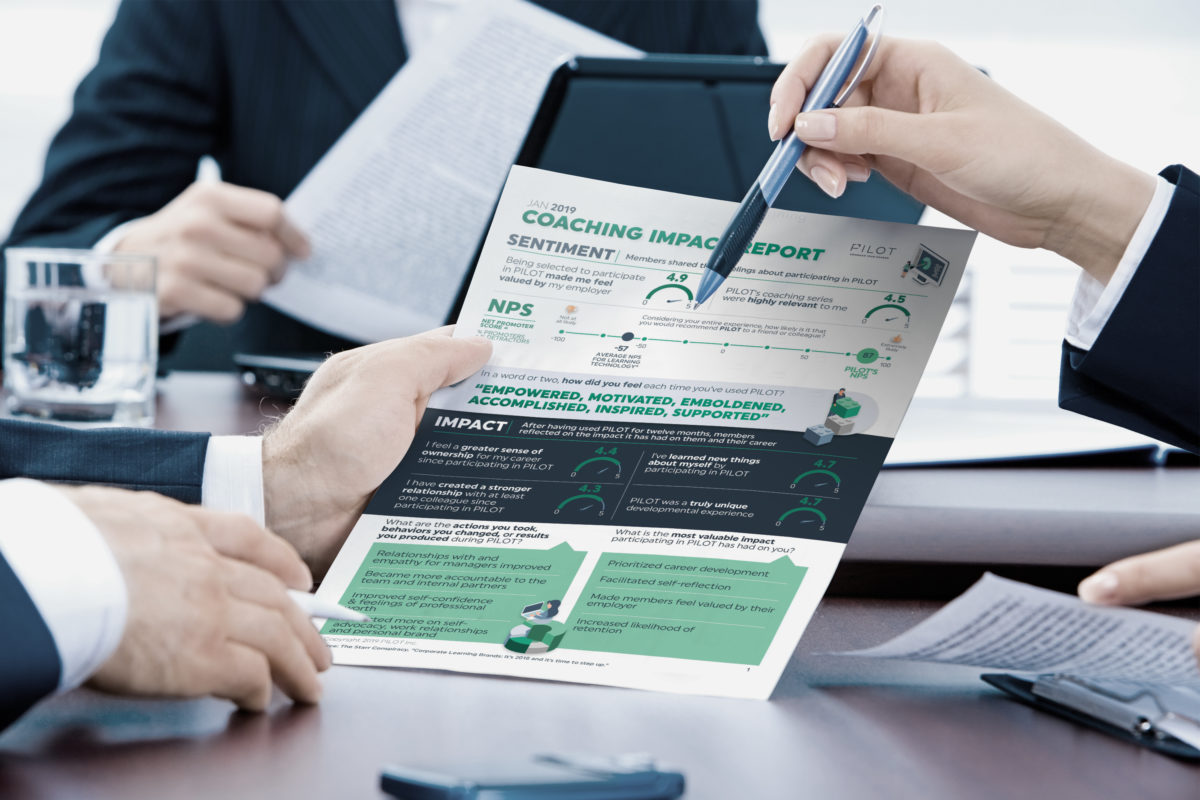
The Perfect Human-machine Symbiosis – How Talent Management Software Can Transform HR
Radar spent time talking to the founder and CEO of PILOT, an innovative SaaS product that offers talent management and development to a growing cadre of aspiring employees that have traditionally been neglected by their managers – to everyone’s cost.
As Ben Brooks describes his background it is abundantly clear that he has applied his wealth of experience, a great deal of thought (and his life savings), to reach his current state as founder of a business that deploys employee development software in some of the largest multinational firms in the US. The investment is paying off – PILOT was just named No1 HRTech Startup to Watch in 2020 by a leading analyst and also won the HRTech pitchfest at one of the industry’s largest annual conventions.
He has been heavily influenced by an early exposure to data; first through his father as a scientist, and subsequently in his early roles in the HR sector. This leaning then started to shape his view that software and machines could empower humans, rather than placing reliance on mantras or frameworks as the more traditional main tenets that are used in HR management.
Data from birth
Ben worked at Enterprise Rent-a-Car, a totally performance- measured business that drives promotion. All the opportunities there were totally transparent. A mix of 20 different data sources were used to create a composite that established who got ahead. Ben saw how data was used in a formulaic and effective way. While at Lockheed Martin, it was all about science and engineering; everything had to be proven. He completed Lean SixSigma blackbelt training and learnt how using data meant solving problems better, understanding root causes, where the leaks and waste exist, and how to analyze a complaint to form the best solution. His next stop was management consulting at Oliver Wyman, known as “the data firm” when compared to its competitors. They proved things through data insights.
The HR journey begins…learning to talk in the C-suite’s language
Ben’s early observations in HR at the global professional services firm, Marsh & McLennan, were how “data poor” the function was compared to other parts of an enterprise at the turn of the century. While a paradigm shift is now underway, at that time it was exciting to be able to use some form of measurement in even the most basic sense. He and colleagues started doing innovative things, but had to set clear goals that were steering-committee approved and based on benchmarks. Goals were hit and one (with a 700% success rate) was covered in the CEO’s quarterly statement for achievement.
This was the first sign of HR starting to speak the language of business: Finance offered charts and numbers; Ops had product and service delivery and execution inventory; Sales and Marketing was fast transforming into a digital and data-centric function; even Compliance/Legal was starting to adopt and explore data sets differently. HR was still talking about individual employee matters, regulatory concerns and cost – its primary mandate was, and still is, to control risk and cost.
People “upside” is the real potential for ROI
In a service economy the vast majority of cost is people related; this can amount to 80% of cost at many firms. Yet the most effective way to improve returns by a minimal percentile is to extract more from what is invested in people, rather than reduce what is put in.
A number of key trends are making the opportunity for big returns in talent management more achievable now. People are much more distributed in their work than before; broadband, mobile and Cloud have all played a part. This changes how cultures develop and impacts how firms manage, train and engage employees.
Employees also have much higher expectations due to advances in consumer tech, and far more empowerment from information transparency. We are part of a “one-click society” that appeals to all generations; the norm now is seamless, flat design and relevant service. The contrast when encountering corporate, enterprise-grade hardware/software in the workplace is striking, which then affects the employees’ perceived value of their company. Most employees enjoy the best technology at home, not in the office.
Career pathing is a dying art at many organizations. Previously people might have stayed with the same employer for 20 years on their journey to MD with defined levels, programs and competencies. Organizations are now divesting, merging, reorging and changing so often that employee loyalty is rare; this in turn affects the amount the enterprise is prepared to invest in an individual if the expectation is that they will move on in three years time.
The last significant trend relates to diversity. A one-size-fits- all model applied top-down for talent management and HR engagement won’t work now. People have very different points of view, motivations, loyalty and starting places. Work has never been that flexible to individual customisation and in decades before demanded mass conformity, rather like joining the military. This does not fit for Gens Y and Z who don’t want to conform. The challenge for the modern HR person is very different and the function is largely unprepared.
Modern times require modern approaches
HR teams are taking on the responsibility for training, engagement, culture and talent management, and are using third parties to get the best results rather than just looking to save. LinkedIn surveys of HR leaders are showing increased spend on talent management.
One of the biggest risks in talent management is the frontline manager; so much is predicated on this person and they are often the single biggest point of failure. Flatter organizations result in greater numbers of people to manage; there are not many jobs now that are purely managerial, with most expected to contribute individually. The employee experience is hugely impacted by the quality of their manager, which can vary significantly.
The value and methodology behind a talent review is currently lost on the market. There are a plethora of performance- management tools that wrap together goal-setting, benchmarks, and performance-based CRM with calls made, touches and resolutions. But these tools ignore “potential”. Talent reviews assess the bench strength of an organization and are a crucial part of succession planning.
Recruiting hinders talent management and in some respects is the enemy of employee development. The recruitment industry has short-term goals and does not operate in the best interest of retention or maximizing potential; yet recruitment technology still receives the lion’s share of venture capital and the HR IT budget, despite many questioning its efficacy.
Activate, empower, perform
PILOT’s whole essence is to activate and empower individual employees – this is what will change a company and improve performance. A lot of money has been put into employee engagement and listening tools top-down, but as employees have been measured more, their engagement has only been reduced. Listening on behalf of management and then failing to act only breeds resentment. Variants on perks, office design and “happy hours” have been tried; the reality is that employees react badly to rigid boundaries that restrict them from doing what is really important to them at a certain time in their life/career (eg wanting to coach my kid’s soccer team at 3.30pm each Friday). Employers need to lean in to what motivates their staff, which will vary by individual.
What makes employees tick – and what ticks them off
PILOT gives management an insight into what works for their employees and what irritates them. The challenge is that the highest performers leave the least time for self-development and are most likely to be self-driven and self-directed. Awareness of their state of mind and needs is minimal and this makes them especially vulnerable to recruitment if the timing of an approach is opportune – the loss to the enterprise is large. Most learning and development content goes to the bottom 25% of employees as they have the time to do it; meanwhile their effective peers are out delivering.
“If we are not marketing to our own employees, we are the only ones who are not”
Training and development is based around transference of knowledge and development of skills. People without access to coaching/mentoring often get to a fork in the road and ask themselves if they are happy, and consider leaving their employer. The recruiting complex preys on this state, seeking out a passive employee, saying disruptively that they might be happier somewhere else. One CHRO at a Fortune-250 firm said, “if we are not marketing to our own employees, we are the only company that isn’t!” Often an employee does not know the root cause of why they are unhappy. Even if they move, candidates are often extremely information-poor in terms of the new organization, and people wrongly advertise change as risk-free improvement.
Coaching is about an individual getting to know themselves; an exec coach cannot read minds nor tell individuals what to do. They can become aware of how they can help and develop their own careers. The process is like conducting a board meeting for yourself on the strategic, longer- term view of your professional prospects, with some perspective on all the facts. It is common to do this analysis of an organization, but not an individual.
So much thought and energy is devoted to how to make the company do better and differently, but companies with more than 100 employees, especially large ones, are very difficult to change. In the last 30 years billions of dollars have been poured into trying to achieve top-down change, yet the employee experience and people management remains broadly the same. Person-based management assumes the person knows themselves best and what they need and value; they need to be empowered with facilitation, objectivity, accountability and support. This is not something typically addressed in common management approaches and HR technology.
The future of work is self-directed – be “intrepreneurial” to get ahead
While employee control is on the decline, empowerment is not on the rise to match it. The future of work involves a huge element of self-directed work. This is not about policies and rules, but judgment and instinct that support communication and being “intrepreneurial”. Intrepreneurial behavior reflects entrepreneurial skills inside an organization and is now recognized as the most desired employee competency set by Fortune 500 CEOs. They are craving the spirit and thinking that innovators and risk takers who take ownership can bring to the business, to be creative and drive change at all levels of a firm. PILOT’s software is designed to spark that state in each of us, to engage a sense of agency, ownership and advocacy.
How does PILOT work in practice?
PILOT’s software assumes that management and the company are not going to change, but the employee can. The employees take the responsibility and ownership for improving themselves and the company. PILOT takes traditional executive coaching and democratizes it through SaaS and Cloud-hosted technology. It offers a 52-week program with weekly cadence. Most traditional talent management is intensity-driven with an event (training, offsite, assessment) or talent-development plan with little sustainable support, follow-up or measurement.
PILOT requires just 10 minutes a week on a smartphone, where and when the candidate wants. Once a month the candidates get together for group video cohort coaching which is interactive and dynamic. This encourages people to collaborate and changes behaviors in the long term. The structured approach does not try to cover everyone’s unique needs (covering the 80/20 that most need to find satisfaction and success in their role) but encourages them to take ownership of their career and feel powerful at work. PILOT also offers a post-platform strategy, sent direct to the employee via text/email. They click a link (every device is frictionless) and it nudges them and reminds them if they are getting behind.
Coaching is often unstructured, but PILOT’s approach provides more structure and leverages data to improve the product, creating a shared experience unlike typical coaching. The engagement will be shared with management and HR as a layer of insight and analytics that is never usually available. The firm might know they have a turnover issue, but they know little about individual career goals or the untapped desires of their best people. The hope is that these insights lead to more targeted action, which is usually where siloed employee listening fails.
PILOT collects these insights 52 times a year to reveal unmet needs and show how much time is being claimed back per employee; most claim back at least one hour per week as the program begins. The program coaches them on how to win with their manager and treat them like a customer. It highlights where an individual is struggling with their manager and treats the manager like a customer, rather than someone who works with the employee.
The way the reports are packaged is vital.The look and feel is as important as the content. PILOT offers beautiful reports with embedded video, infographics, icons, and pithy and punchy commentary. It makes HR look great and delivers new insights from the top talent in the organization. This is a different voice to the usual complaints, and changes the success profile for that HR person.
The approach is practical and rooted in research and fundamentals such as planning, communication, discipline, focus, compromise, time management and prioritization. This technology is not taking the place of people; it is helping people to be successful, a symbiosis that is repeatable, structured, efficient and on demand. Humans don’t want to coach candidates at 9pm each night, but that might be the only window that high-performers, who might also be working parents, get to develop themselves.
The system presents data as interesting and observational, but asks the employer and employee to draw the conclusion. PILOT works with them rather than doing the work for them. PILOT can give back the value of one fulltime employee each year, at least, from saving one hour of time per week per employee.
The Cadillac brand strategy team was paying double the market rate to retain its talent. It had resorted to hiring from outside the traditional auto sector and many found their new environment too tough and wanted to leave, with remuneration irrelevant. The PILOT system improved retention by revealing unmet needs. In one instance, an employee wanted to do an international assignment, when her manager thought she wanted to start a family. She was never offered an international role. But she wanted to do this before she had a family. They had a role in Zurich that they had no idea how to fill, they fully backed her needs and she was there 30 days later. She had advocated for herself by declaring her need. It totally changed her career, and then she had a baby. She got it all.
Despite having millions invested in so many different solutions, PILOT enabled MetLife to achieve record retention and promotion rates in sales for women; previously the firm struggled to achieve its goal to promote more women in sales because so few were applying. The software gave them confidence and assurance. Such was the change that the employees spoke at their Women in Sales Summit about how PILOT helped them to change their client portfolio and allowed them to focus on their physical needs, health and wellness. Even when working at a company with great medical insurance, they were not using it to manage their health issues by consistently deprioritizing themselves.
And why do managers love PILOT?
Employers have said that PILOT positively changes their employees’ behavior. They like what they see. They have a lot more swagger and attitude. One manager had three separate one-on-ones on the same day after a PILOT group video coaching session. Each individual asked their manager what they could do to help her. Despite being at that firm for 20 years, no one had ever asked her that before and it brought a tear to her eye.
PILOT teaches employees that they need feedback, and tells them how to solicit, process and understand critical development feedback. This can come from anyone, not just from managers, but also customers, vendors, support and team leads. PILOT also encourages its cohort to create an Owners Manual for themselves about what has happened in their lives, and the values and skills they bring, irrelevant of their academic background. It provides a holistic overview about how to get the best out of that person. It describes the things to avoid, their “please do and please don’t” list. Sharing this delivers some big “aha moments” when getting to know someone and the way they reacted previously. It allows people to start to negotiate their relationship with their colleagues in a very human, vulnerable and authentic way. This simple, unstructured approach drives connection and how to treat each other and work together.
Management loves the data but they love being appreciated even more. The management tax is just 30 minutes per month to go over the analytics on a call. If they have to send a note to the cohort, PILOT drafts it. It is turnkey, time-efficient and requires zero mindshare. The objective position allows the right messages to be communicated back and forth by a neutral messenger; PILOT is the employee’s advocate and all messages are in support of their development and learning. Messaging that was previously ignored or resisted starts to get through.
Longer term, PILOT aims to be the Bloomberg terminal of professional performance; it makes individuals better and smarter as an embedded link to high performance. It is the perfect human-machine symbiosis to drive consistency and efficiency so that the future of work becomes more self-directed. PILOT helps individuals navigate and propel themselves, setting the right course and velocity.
Follow Ben @benbrooksny or email him [email protected].







